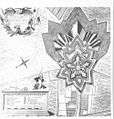Fort Bourtange
| Fort Bourtange | |
|---|---|
| Bourtange, Groningen, Netherlands | |
|
Fort Bourtange from the air | |
 Fort Bourtange | |
| Coordinates | 53°00′22″N 7°11′31″E / 53.006°N 7.192°E |
| Type | Star fort |
| Site information | |
| Open to the public | Yes |
| Condition | Intact |
| Site history | |
| Built | 1593 |
| In use | c. 1593-1851 |
| Events |
Eighty Years' War, Third Anglo-Dutch War |
Fort Bourtange (Dutch: Vesting Bourtange) is a star fort in the village of Bourtange, Groningen, Netherlands. It was built in 1593 under the orders of William the Silent. Its original purpose was to control the only road between Germany and the city of Groningen, which was controlled by the Spaniards during the time of the Eighty Years' War.
After experiencing its final battle in 1672, the Fort continued to serve in the defensive network on the German border until it was finally given up in 1851 and converted into a village. Fort Bourtange currently serves as a historical museum.
History
During the Eighty Years' War (1568 - 1648), the Spaniards had control over Groningen and the road leading from there to Germany. William, the leader of the Netherlands, saw it necessary to break off communications between Groningen and Germany. He decided that it would be optimal to build a fortification on the Bourtange passage, which was the main road leading to Germany. The fort was completed in 1593 in the design of a star fort with a network of canals and lakes which were used as moats (which were also constructed in the design of stars). At the time of its completion, the fort housed five garrisons. Soon after its construction, Spanish forces from Groningen besieged it, though the attack ended in failure.[1]
Fort Bourtange faced another battle in 1672 against invading forces of the Prince-Bishop of Münster, France's German ally in the Franco-Dutch war. After capturing 18 cities and towns in the northern Netherlands, they demanded that the Fort be surrendered. The fort's governor, Captain Protts, refused this demand, and the Münsters replied with a frontal assault. Thanks to the surrounding marshes and the time-tested fort defenses, the invading army was repelled successfully.[2]
After its eventual secession and conversion into a village in 1851, living conditions began to deteriorate. Over 100 years later in 1960, the local government decided that to combat this growing problem the old Fort would be restored to its 1740–50 appearance and made into a historical museum. This provided valuable tourism for the surrounding village. The Fort remains a museum today.
Gallery
- Bourtange fortification
.jpg) Bourtange, Atlas van Loon 1649
Bourtange, Atlas van Loon 1649 Plan of Bourtange, 1742
Plan of Bourtange, 1742 Centre of the village
Centre of the village Windmill at Bourtange
Windmill at Bourtange Church at Bourtange
Church at Bourtange The former synagogue (now a museum)
The former synagogue (now a museum) Pikiner and Musketeers
Pikiner and Musketeers gunfire
gunfire
Footnotes
References
- George Sale, George Psalmanazar, Archibald Bower and several others, An Universal History, From the Earliest Accounts to the Present Time, Vol. 45, 1779
External links
| Wikimedia Commons has media related to Vesting Bourtange. |
